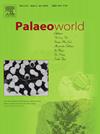寒武系Wirrealpa灰岩一种新的圆壳类腕足动物;第四阶段,弗林德斯山脉,南澳大利亚
IF 1.7
3区 地球科学
Q2 PALEONTOLOGY
引用次数: 0
摘要
卵足类是一种单系的钙质腕足类动物,分布在世界各地,常出现在二系(第4期)-庙岭涧系(五流期)边界附近。这个鲜为人知的分类群,Obolella wirrialpensis Etheridge, 1905年,最初描述于弗林德斯山脉的下寒武纪Wirrealpa石灰岩,它有几个独特的特征,包括突出的“阶梯”同心片层,而且不寻常的是,它没有任何类型的放射状点缀。腹瓣具有明确的渐尖喙,在凸起的、正斜的腹区间平台的左侧有一个不对称的单齿,该平台与背瓣的宽中间缺口对齐。这一独特的特征表明,该分类群是一个新的特有的球壳动物属,在这里被修正为Jagoellus n. gen.,是澳大利亚Chalasiocranos-Kaimenella shelly化石带和Kostjubella djagoran下腕足动物组合带的一部分。本文章由计算机程序翻译,如有差异,请以英文原文为准。
A new obolellid brachiopod from the Wirrealpa Limestone (Cambrian; Stage 4), Flinders Ranges, South Australia
Obolellids are a monophyletic group of calcareous brachiopods with a worldwide distribution that often occur near the Series 2 (Stage 4)–Miaolingian Series (Wuliuan Stage) boundary. The poorly known taxon, Obolella wirrialpensis Etheridge, 1905 originally described from the lower Cambrian Wirrealpa Limestone in the Flinders Ranges has several unique character traits including prominent “stepped” concentric lamellae and, unusually for the family, lacks any type of radial ornament. The ventral valve has a well-defined acuminate beak and single asymmetrical tooth on the left side of a raised, orthocline ventral interarea platform that aligns with a wide median notch in the dorsal valve. This unique suite of character traits reveals the taxon to be a new endemic obolellid genus, here revised as Jagoellus n. gen., part of the late Stage 4 Chalasiocranos-Kaimenella shelly fossil zone and lower Kostjubella djagoran brachiopod assemblage zone from Australia.
求助全文
通过发布文献求助,成功后即可免费获取论文全文。
去求助
来源期刊

Palaeoworld
PALEONTOLOGY-
CiteScore
4.00
自引率
5.90%
发文量
95
期刊介绍:
Palaeoworld is a peer-reviewed quarterly journal dedicated to the study of past life and its environment. We encourage submission of original manuscripts on all aspects of palaeontology and stratigraphy, comparisons of regional and global data in time and space, and results generated by interdisciplinary investigations in related fields. Some issues will be devoted entirely to a special theme whereas others will be composed of contributed articles. Palaeoworld is dedicated to serving a broad spectrum of geoscientists and palaeobiologists as well as serving as a resource for students in fields as diverse as palaeobiology, evolutionary biology, taxonomy and phylogeny, geobiology, historical geology, and palaeoenvironment.
Palaeoworld publishes original articles in the following areas:
•Phylogeny and taxonomic studies of all fossil groups
•Biostratigraphy, chemostratigraphy, chronostratigraphy
•Palaeoecology, palaeoenvironment and global changes throughout Earth history
•Tempo and mode of biological evolution
•Biological events in Earth history (e.g., extinctions, radiations)
•Ecosystem evolution
•Geobiology and molecular palaeobiology
•Palaeontological and stratigraphic methods
•Interdisciplinary studies focusing on fossils and strata
 求助内容:
求助内容: 应助结果提醒方式:
应助结果提醒方式:


